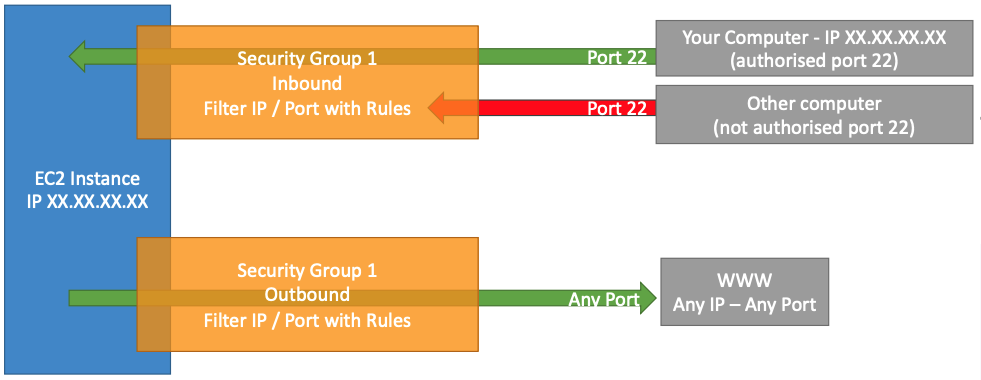# Security Groups
A Security Group (SG) is a virtual firewall for your EC2 instances, RDS databases, ECS tasks, and other AWS resources at the instance level.
- Security Groups are the fundamental of network security in AWS
- They control how traffic is allowed into or out of our EC2 Instances
- Security groups only contain allow rules
- Security groups rules can reference by IP or by security group

# Deep Dive
- Security groups are acting as a Firewall on EC2 instances
- They regulate:
- Access to Ports
- Authorised IP ranges - IPv4 and IPv6
- Control of inbound network (from other to the instance)
- Control of outbound network (from the instance to other)

# Example
[ Internet ]
│
▼
[ ALB Security Group ]
Inbound: 80,443 from 0.0.0.0/0
Outbound: 8080 to App SG
│
▼
[ App Server Security Group ]
Inbound: 8080 from ALB SG
Outbound: 3306 to DB SG
│
▼
[ Database Security Group ]
Inbound: 3306 from App SG
# Example 1 — Basic Web Server Security Group
| Direction | Protocol | Port Range | Source/Destination | Description |
|---|---|---|---|---|
| Inbound | TCP | 22 | Your IP (e.g. 203.0.113.10/32) | SSH access |
| Inbound | TCP | 80 | 0.0.0.0/0 | Allow HTTP (web traffic) |
| Inbound | TCP | 443 | 0.0.0.0/0 | Allow HTTPS (secure web traffic) |
| Outbound | All | All | 0.0.0.0/0 | Allow all outbound traffic |
# Example 2 — Private App Server (Only From Load Balancer)
| Direction | Protocol | Port Range | Source/Destination | Description |
|---|---|---|---|---|
| Inbound | TCP | 8080 | SG of Load Balancer (sg-xxxx) | Allow only traffic from ALB |
| Outbound | TCP | 3306 | SG of Database (sg-yyyy) | Allow DB access |
| Outbound | All | All | 0.0.0.0/0 | Allow other outbound (optional) |
# Example 3 — Database Security Group
| Direction | Protocol | Port Range | Source/Destination | Description |
|---|---|---|---|---|
| Inbound | TCP | 3306 | App Server SG (sg-xxxx) | Allow DB access from app servers |
| Outbound | None | — | — | Databases rarely initiate outbound traffic |
# Good to know
- Can be attached to multiple instances
- Locked down to a region / VPC combination
- Does live “outside” the EC2 – if traffic is blocked the EC2 instance won’t see it
- It’s good to maintain one separate security group for SSH access
- If your application is not accessible (time out), then it’s a security group issue
- If your application gives a “connection refused“ error, then it’s an application error or it’s not launched
- All inbound traffic is blocked by default
- All outbound traffic is authorised by default
# Classic Ports to know
- 22 = SSH (Secure Shell) - log into a Linux instance
- 21 = FTP (File Transfer Protocol) – upload files into a file share
- 22 = SFTP (Secure File Transfer Protocol) – upload files using SSH
- 80 = HTTP – access unsecured websites
- 443 = HTTPS – access secured websites
- 3389 = RDP (Remote Desktop Protocol) – log into a Windows instance